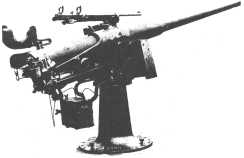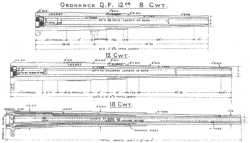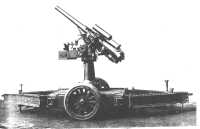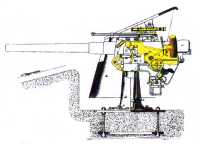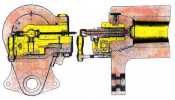|
| |||||||||||||||||||||||||||||
QF 12-pr | |||||||||||||||||||||||||||||
When QF guns were first introduced in 1880 the Royal Navy was the first customer. In 1881 the RN saw the need for a light QF gun to combat fast motor torpedo boats (MTBs), and two years later adopted the Hotchkiss 6-pr for the purpose. In 1885 the Royal Artillery adopted the Nordenfelt QF 6-pr for coast artillery, also to combat MTBs. As both Hotchkiss and Nordenfelt had performed equally well during trials both had been accepted into the services. Navy preferred the former, Army the latter. As MTBs became bigger, faster, and more powerful a better gun was needed to deal with them. Thus the QF 12-pr was introduced in 1894 with Army also adopting it for coast defence. |
| ||||||||||||||||||||||||||||
|
Four QF 12-pr equipments as shown in Fig. 1 were received in New Zealand in 1900, and in 1901 were installed, two at Fort Cautley, Devonport, and two at Fort Ballance, Wellington (later moved to Fort Dorset, Seatoun). It seems at this stage the Government did not believe South Island ports were worth defending. | |||||||||||||||||||||||||||||
The gun was of the usual built-up construction (see Fig. 2), but possessed a unlque feature: the breech mechanism did not have extractors! A member of the detachment was provided with a hook-like implement with which he jerked the fired case from the chamber, thus performing extraction and ejection in one 'go' as it were. Apparently it worked reasonably well for no one ever requested extractors. However, they were fitted near the outbreak of World War 2. |
| ||||||||||||||||||||||||||||
|
About the same time as the 12-pr 12-cwt was introduced, a 12-pr 8-cwt was proposed as a ship, boat or field marine gun, ie for the support of Naval landing parties. However, the gun was mounted on a field carriage typical of those then in use by the Royal Artillery. The recoil system was not efficient and drag shoes had to be used under the wheels to keep the carriage steady in action. It is understood the Navy were not happy with the equipment and demanded a 'less powerful gun'. The introduction of 'torpedo-boat destroyers;' later simply known as 'destroyers', led in 1903 to the production of a number of 12-prs of 18-cwt. These were similar to the 12-cwt guns but were 10 calibres longer. See Fig. 2. | |||||||||||||||||||||||||||||
The 12-pr on a high-angle mounting was adapted to the anti-aircraft role during World War 1, after which it reverted to the coast role. Some were 'resurrected' during World War 2 for use on defensively armed merchant ships (DEMS). See Fig. 6. The 12-pr remained in service until the abolition of coast artillery in 1956 (1959 in New Zealand). How a 12-pr came to be preserved in the Army Museum is interesting. As Gunners serving during the 1950s well remember the Government sold all coast artillery equipment as scrap meta1 - including near-new guns, e.g. BL 9.2 and 6-inch Mark 21 and 24s. Army made no attempt to retain any item for historical purposes. | Fig 6: QF 12-pr 12-cwt in anti-aircraft role on travelling carriage. The same equipment - less the carriage - was used on defensively equipped merchant ships (DEMS) during World War 2. | ||||||||||||||||||||||||||||
|
Determined to rescue something, members of 9 Coast Cadre, then stationed at the Artillery Yard, Devonport, dismounted one of the 12-prs then concealed it under a heap of rubble. The scrap merchant came and went but the gun remained. After allowing a suitable length of time to elapse, the Cadre 'resurrected' the gun and mounted it at Narrow Neck Camp. Eventually it found its way to the Museum. Unfortunately while the equipment lay unguarded thieves stole some of the brass fittings, e.g. the pistol grip, but the bulk survives. | |||||||||||||||||||||||||||||
| |||||||||||||||||||||||||||||
|
ADDITIONAL DATA FOR 12-cwt EQUIPMENT:
|
| ||||||||||||||||||||||||||||
WL Ruffell
Guns at Waiouru | Guns around New Zealand | More equipments | Home | |||||||||||||||||||||||||||||
